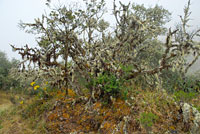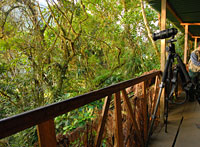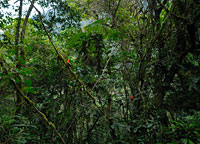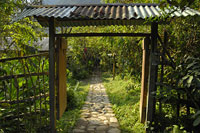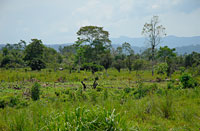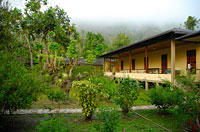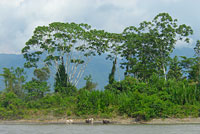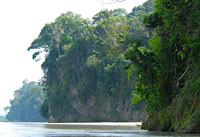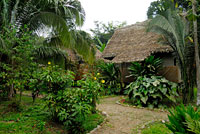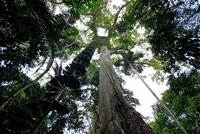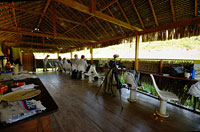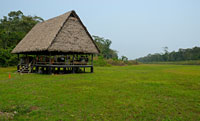Trip Report: Manu National Park, Peru 2006From the Andes to the Lowland RainforestIntroduction Manu National Park is well known for its biodiversity. Over 1000 bird species make it a highlight for birders, but diversity in general is stunning for any taxonomic group, of both animals and plants. This trip was the best nature experience so far; we felt like visiting the heart of evolution, with its most diverse strategies for survival and each species trying to stay a leap ahead by either exploiting niches, co-evolving with food plants, competitors or enemies. Only the long-term stability of the Rainforest ecosystem (being mostly unaffected by ice ages and other climate changes) on the Eastern side of the Andes made the development of such a huge diversity of life and life-strategies possible. We hope that future generations will still be able to visit such stunning ecosystems. On the trip we went through almost all ecosystems of Manu National Park, beginning at the edge of the rainforest or elfin forest, down to the cloud forest and proceeding even more down to the lowland rainforest. The high species diversity in Manu is partly attributed to the fact that Manu covers such a huge range of altitudes from approx. 3600 m down to only a few hundred meters, each with its typical and sometimes endemic species.
IncaNatura organized this trip for us, a company being specialized in ecotourism in Peru. Juan Carlos Cardenas was very helpful during the planning phase answering many questions. And Percy Avendaño was an excellent and patient guide, whom we would like to thank here. He did his best to show us as much as possible in only 6 days.
Cusco, Laguna Huacarpay and Andes After leaving Cusco by car at 5:30h we reached the Huacarpay lagune half an hour later. Apart from various water birds we encountered several Giant Hummingbirds (Patagona gigas) feeding and defending their territories. Since I was especially interested in hummningbirds, we left the lagune after an hour trying to find further good spots for hummingbirds on our way through the Andes. We did find good spots for Bearded Mountaineer (Oreonympha nobilis), Tyrian Metaltail (Metallura tyrianthina smaragdinicollis) and others on the way to Paucartambo. Manu National Park, near Tres Cruces On the way through the Andes, where we reached an altitude of approx. 3950 m, the landscape was dry and often rocky (in the higher altitudes dominated by Ichu grass). But only a few kilometers before reaching the edge of the rainforest, i.e. before reaching the eastern slopes of the Andes, the landscape was suddenly green again; apparently moisture from the rainforest occasionally swapped into the proximate valley of the Andes. When finally reaching the edge of the rainforest, clouds and cold moisture were suddenly surrounding us and the humidity was condensing to droplets on all trees, grass and lichens. The overwhelming humidity together with miniature trees and brushes, full with lichens and mosses, produced an atmosphere which is very well described by the term ďelfin forestĒ. Here at the upper edge of Manu National Park we stopped to have lunch and to take pictures of a Shining Sunbeam (Aglaeactis cupripennis ), a humming bird with rather long wings (which is typical for hummingbirds living in the thin air of the upper Andes). As flowers are scarce in the elfin forest, hummingbirds spend more time resting than elsewhere, thereby saving energy. After lunch we proceeded our descent and the forest became gradually denser and higher. When we reached the first tree ferns we knew that we had reached the cloud forest (upper montane rainforest). We had the luck to see a group of Woolly monkeys (Lagothrix lagotricha) which were slowly passing from tree to tree with their prehensile tails. Although we hoped to see a Quetzal we didnít have the luck to see one, but we saw a Highland Motmot (Momotus aequatorialis, unfortunaly too far away to take a good photograph). Soon later, we reached Cock of the Rocks-Lodge, where we would spend the night. Cock of the Rocks-Lodge Practical information: Electricity only in the evening for a few hours (generator). Showers with warm water (gas powered). Mosquito nets available (covering the beds). As itís name suggests, the Cock of the Rocks Lodge is mainly known for the nearby lek (a display arena) of the Andean Cock-of-the-Rock (Rupicola peruvianus, Gallito de las Rocas). And it does in fact offer an excellent opportunity for observing the very interesting display behavior of the males, dancing and grunting within only a few meters, each one sitting on its own branch. It becomes even more interesting when a female comes by (which is brown and smaller than the colourful red-black males), causing everybody to show its best display. Since the lek is only a few meters from the platform itís a unique spot for photography too, though itís quite dark in the early morning when the display behavior starts (we went there before down). We planned our trip in September because at that time the breeding behaviour of the Cock-of-the-Rocks has already started but itís still just before the rainy season, which starts in October (this was also an excellent choice in terms of mosquitos, we had very few of them, but a few years later we chose to visit the rainforest in the rainy season and it was a mess regarding mosquitos). However, Cock-of-the-Rocks visit their leks throughout the year (seemingly in order to not lose their dancing territory), but to experience the full activity itís best to come during the breeding season. The lodge itself was the best place for Hummingbird photography I have ever seen. Several flowering bushes and a few feeders were attracting so many of them that it was hard to focus on a particular species. The most abundant species were Many-spotted Hummingbird (Taphrospilus hypostictus), Green Hermit (Phaethornis guy), Wire-crested Throntail (Discosura popelairii), Violet-fronted Brilliant (Heliodoxa leadbeateri), Long-tailed Sylph (Aglaiocercus kingi) and Booted Racket-tail (Ocreatus underwoodii). Many of them were not shy at all, feeding sometimes only a meter away. The people from the lodge attracted several Tanagers (e.g. Silver-beaked Tanager, Ramphocelus carbo) with some fruits. Later also an Aguti fed on the fruits and also small group of Black-capped Capuchin (Cebus apella) visited the lodge offering again an excellent opportunity for photography. The incredible abundance of life didnít leave me any time for breakfast and filled all memory cards within an hour, so before leaving for a walk on the road I had to copy all files on my hard disk. Way to Atalaya After a walk on the road where we were successfully looking for mixed flocks of birds (Tanagers, Woodpeckers, Oropendolas named Oro-pendola for their golden colour and pending nests) we proceeded to Atalaya, where we would continue our trip with the boat. On the way we crossed large cultivated or at least partly cultivated areas. After a day in the dense, untouched cloud forest it was sad though remarkable to see the marked change of the landscape by human agriculture. For wildlife, the next hours to Atalaya were not too rewarding, we saw some bird species and a Nine-banded Armadillo (Dasypus novemcinctus), run over by a car. In Atalaya we left the car and took a boat for the rest of the journey. This day, however, we only headed to the nearby Amazonia lodge. Amazonia Lodge Practical information: Electricity only in the evening for a few hours (generator). Showers with warm water (solar powered). No mosquito nets covering beds available, though mosquito nets on the windows. Amazonia Lodge is a large lodge with a relatively ample garden. The lodge in built in a secondary rainforest, which was formerly used for agriculture. Consequently, most parts of the surroundings consist of typical plants of earlier successive stages, like Cecropia trees. Further away from the lodge is also a little mountain covered with primary forest, but since we started to walk through the surroundings, we didnít have time to visit it. Despite of several hummingbird feeders we didnít see many hummingbirds here, except for a rather tame Golden-tailed Sapphire (Chrysuronia oenone). The garden offered good viewing opportunities for several Tanager species though (e.g. Masket Crimson Tanager, Ramphocelus nigrogularis) and Oropendolas (e.g. Russet-backed Oropendola, Psarocolius angustifrons). Just a few meters from the garden was a tree with a resident group of Peruvian Night Monkey (Aotus miconax). Later in the evening a Coati (Nasua nasua) passed by, while we were resting. In the surroundings we saw Emerald Toucanets (Aulacorhynchus prasinus) and Chestnut-eared Aracari (Pteroglossus castanotis), amongst other birds. From Amazonia Lodge to Manu Wildlife Center
We passed the third day almost entirely on the boat driving from Amazonia Lodge to Manu Wildlife Center, which is about 100 km downstream.
On the way we saw several King Fishers, Herons and Egrets (Snowy Egret, Egretta thula, Cocoi Heron, Ardea cocoi, Capped Heron,
Philherodius pileatus, an others) and Jabiru (Jabiru mycteria). Compared to other regions in the Peruvian rainforest, where
we knew that hunting was an issue, animals were rather tame on this trip.
Now at the end of the dry season, the river with its low water level was still full of trunks of fallen trees, which had fallen into the water
when the torrential waters during the rainy season dig away considerable amounts of soil on the river banks. It is remarkable to see how the
water forms the shape of the rivers and that shape changes over time (see e.g.
satellite images of Rio Madre de Dios). Usually on the outside curve of the river soil is dug away while on the inside curve soil is
deposited forming new terrain with typical successive plant communities. Manu Wildlife Center Practical information: Electricity only in the evening for a few hours (generator), Showers with warm water (gas powered). Mosquito nets (covering beds). Manu Wildlife Center is not located in Manu National Park, but it offers excellent wildlife viewing opportunities. Animals anyway donít know the borders of the park and since hunting doesnít seem to be an issue in the region, animals are tame. The advantages of Manu Wildlife Center are several hides or platforms, and a good path network in which it is quite easy to follow animals, especially monkeys. Apart from a canopy platform in a huge (!) Ceiba tree, there is a hide at a mammal clay lick and a hide near a clay lick (Colpa) for Aras and Parrots. When walking up the stairs to the canopy platform, you really notice how much you miss in a rainforest, when you only walk on the ground. On the platform, we had an excellent view, but unfortunately didnít see as much wildlife as expected (which was probably bad luck, if a mixed species flock would have passed it would certainly have been impressing). The mammal clay lick was very luxurious with mattresses and mosquito nets where visitors could wait and sleep a bit until an animal arrives. A group which was there at the same time didnít have too much patience though and they left after a few hours. A few hours later (without any sleep because I was enjoying the incredible sounds of the rainforest at night and wanted to be ready for whatever comes) we had the luck to see a Tapir (Tapirus terrestris), a Giant Armadillo (Priodontes maximus) and a Brazilian Porcupine (Coendou prehensilis). On the way back to the lodge we had the chance to see some nighlife too. A night trip through the rainforest is absolutely recommendable, taking a close look at what is hidden in the plants along the path. The hide at the Ara and Parrot clay lick is certainly a highlight of Manu Wildlife Center. The hide was formerly a boat floating in a disconnected branch of Rio Madre de Dios. But it had gradually dried out, with the consequence that the boat was a hide on dry ground when we went there. Although the position of the hide is now not flexible anymore as it was before it still offers excellent viewing opportunities for several Parrots and Aras, visiting the clay lick regularly. I found it particularly interesting to see the interaction between different parrot species and within pairs of Aras. For photography a good tele-lens is necessary though, since the lick is approximately 70-100 m from the hide. The 400 m + 1.4 x teleconverter was not really enough. While watching the clay lick breakfast is served.
The Lodge itself was very nice too. Oropendolas, some Hummingbirds and even a mixed troop of Saddle-back tamarins (Saguinus fuscicollis) and
Emperor Tamarin (Saguinus imperator) were regular visitors. One day three Saddle-back Tamarins made a joint effort to open a cocoa fruit, which
was growing on a tree in the garden. First they tried to tear off the fruit. When this approach failed, they tried to bite a hole in the skin
which took them quite a while. But finally they succeeded and pulled the while flesh out of the fruit with their little arms.
When hiking in the network of paths around the lodge, we saw troups of Black Spider Monkeys (Ateles paniscus) several times. One day an adult Spider Monkey was playing with a juvenile while hanging on a branch only using its prehensile tail. We also observed how a mother was helping their offspring through the canopy by building bridges beween more distant branches. In one occasion a huge mixed troup of Squirrel Monkeys (Saimiri boliviensis) and a few White-fronted Capuchin Monkeys (Cebus albifrons) passed us. Also these species often forage together, sometimes being accompanied also by a Double-toothed Kite (Harpagus bidentatus), which we also saw traveling with them, taking its chance to get prey startled by the flurry of activity of the monkeys. Another highlight of Manu Wildlife Ceter is Cocha Blanca, a small lake about half an hour from the lodge. This lake, a former course of Rio Madre de Dios, was one of the best spots for wildlife photography, with many birds (e.g. several heron and king fisher species, raptors and the always abundant Hoazin, Opisthocomus hoazin). All animals were extremely tame. We silently approached Black Caiman (Melanosuchus niger) and the usually shy herons (Rufescent Tiger-Heron, Tigrisoma lineatum) on a floating catamaran up to a distance of only two to three metres. Of course this was only possible since everbody was really silent enjoying this wonderful eperience. After some time it began to rain, but luckily I had brought a plastic back to cover the camera and the lens. Otherwise I would have missed many good images. On the way back to Manu Wildlife Center we also saw the White Caiman (Spectacled Caiman, Caiman crocodilus) lying on a river bank. Back to Cusco Finally, after three days at Manu Wildlife Center it was time to head back to Cusco. We drove to a small landing strip near the lodge by boat and "checked in" (being weighted with our luggage; in case of overweight, we would fly to Cusco but the luggage would take the next flight the next day). Looking down on the rainforest I imagined how much life was down there, hidden in the mosaic of greens and oranges (flowering trees). In the past six days we had seen an increddible abundance of life, ecosystems and species, although in such a short time it is only possible to see a snapshot of the Peruvian Rainforest. Given that it is hard to imagine how much is still hidden below the vast green canopy waiting for being discovered. → View all photos of this trip Recommended readingCurrently (2010) the best guide for birds in Peru: Schulenberg T.S., Stotz D.F., Lane D.F., O'Neill J.P, Parker T.P. 2007. Birds of Peru (Princeton Field Guides). Princeton University Press, 656 pages. A good guide for neotropical mammals: Emmons L.H. and Feer F. 1997. Neotropical Rainforest Mammals: A Field Guide. University of Chicago Press, 307 pages. A must-read for everybody interested in understanding rainforest ecology: Kricher J. 1999. A Neotropical Companion: An Introduction to the Animals, Plants, and Ecosystems of the New World Tropics. Princeton University Press, 451 pages. A very good book in English and Spanish about Manu National Park: MacQuarrie K. and Terborgh J. 1998. Peru's Amazonian Eden: Manu National Park and Biosphere Reserve. 2nd ed. Francis O. Patthey & Sons, 320 pages. (Photos: A. Bärtschi) Practical considerations
Photography: Since electricity is not available 24 h and plugs may be occupied it is a good idea to carry sufficient (rechargeable) batteries.
I had bad luck with standard rechargeable batteries, which rapidly loose voltage. Since they have a lower voltage anyway
(1.2 V instead of 1.5 V) they were unusable after two days only (maybe due to the high humidity they lost power even more rapidly).
Since that trip I always used Eneloop batteries which I can absolutely recommend. They lose power only very slowly (after months) and
I never again had a problem, even in the rainforest during the rainy season a few years after visiting Manu. Although a week may be too short
for fungi to destroy your lenses or camera, we stored our equipments in zip-locked plastic bags filled with dry silica gel over night.
For longer trips other methods are recommended (you will find information about alternative methods in the web). A lens with
stabiliser and a flash is very helpfull for animals in the dark rainforest. We also brought a tripod, which was very useful for photography
from hides or platforms. Finally, for storing photos a hard drive may be indispensable.
EcotourismItís worth to notice that all lodges try to offer an ecologically sustainable form of tourism. At Manu Wildlife Center we were told for example that food is imported from Cusco and nothing edible is hunted at or near the lodge, although that would be much easier. Also waste is transported back to Cusco. This evidently raises the costs of running a lodge, but I'm sure most admirers of wildlife support this way of tourism. |
 Highlights
Highlights Birds
Birds  Amphibians & Reptiles
Amphibians & Reptiles 


